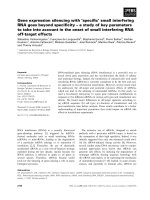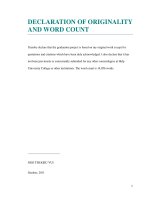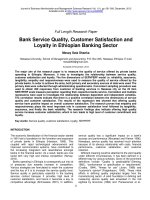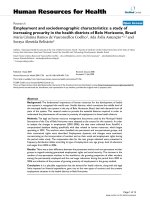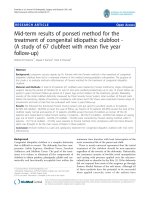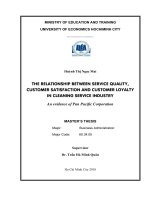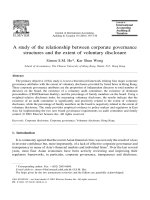Service quality, customer satisfaction and behavioral intentions a study of international flights with low cost carriers in viet nam
Bạn đang xem bản rút gọn của tài liệu. Xem và tải ngay bản đầy đủ của tài liệu tại đây (3.5 MB, 134 trang )
MINISTRY OF EDUCATION AND TRAINING
UNIVERSITY OF ECONOMICS HO CHI MINH CITY
PHAN NGUYEN HOANG LY
SERVICE QUALITY, CUSTOMER SATISFACTION
AND BEHAVIORAL INTENTIONS:
A STUDY OF INTERNATIONAL FLIGHTS
WITH LOW-COST CARRIERS IN VIET NAM.
MASTER THESIS IN ECONOMICS
Ho Chi Minh City, 2019
MINISTRY OF EDUCATION AND TRAINING
UNIVERSITY OF ECONOMICS HO CHI MINH CITY
PHAN NGUYEN HOANG LY
SERVICE QUALITY, CUSTOMER SATISFACTION
AND BEHAVIORAL INTENTIONS:
A STUDY OF INTERNATIONAL FLIGHTS
WITH LOW-COST CARRIERS IN VIET NAM
Major: Business Administration
(Research)
Code: 8340101
MASTER THESIS IN ECONOMICS
Supervisor: Dr. Dinh Thai Hoang
Ho Chi Minh City, 2019
DECLARATION
I commit that “Service quality, customer satisfaction and behavioral
intentions: a study of international flights with low-cost carriers in Viet Nam” is my
own research, which was based on the study and guidance of Dr. Dinh Thai Hoang.
This thesis includes accurate referencing cited from the vast majority of research
published on reputable journals in the world with detailed in-text citations. The
content and results of the analysis are honest and have not been published in any
form before, so the comments, evaluations and conclusions are reliable.
Ho Chi Minh City, 2019
Phan Nguyen Hoang Ly
Table of Contents
Cover page
Declaration
Table of contents
List of tables
List of figures
Abstract
Chapter 1: INTRODUCTION .................................................................................... 1
1.1. Research background....................................................................................... 2
1.2. Problem statement ........................................................................................... 4
1.3. Research objectives ......................................................................................... 5
1.4. Subjects, implication and scope of research .................................................... 7
1.5. Assumptions .................................................................................................... 8
1.6. Research structure ........................................................................................... 9
Chapter 2: LITERATURE REVIEW AND CONCEPTUAL FRAMEWORK....... 11
2.1. Literature review ........................................................................................... 11
2.1.1. Low-cost carriers .................................................................................... 11
2.1.2. Service quality ......................................................................................... 13
2.1.3. Customer satisfaction .............................................................................. 15
2.1.4. Behavioral intentions .............................................................................. 16
2.1.5. The relationship between service quality and customer satisfaction ...... 17
2.1.6. The relationship between customer satisfaction and behavioral intentions
........................................................................................................................... 19
2.2. Conceptual framework and research hypotheses .......................................... 21
Chapter 3: RESEARCH METHODOLOGY ........................................................... 23
3.1. Research strategy and design ......................................................................... 23
3.2. Qualitative research ....................................................................................... 26
3.3. Quantitative research ..................................................................................... 27
3.3.1. Variables and measures .......................................................................... 27
3.3.2. Population and sampling ........................................................................ 30
3.3.3. Data collection ........................................................................................ 31
3.3.4. Data analysis ........................................................................................... 33
Chapter 4: DATA ANALYSIS AND DISCUSSION .............................................. 37
4.1. Respondent demographics ............................................................................. 37
4.2. Descriptive statistics ...................................................................................... 39
4.3. Reliability and validity .................................................................................. 41
4.3.1. Reliability test.......................................................................................... 41
4.3.2. Validity test.............................................................................................. 44
4.4. Hypotheses test .............................................................................................. 51
4.5. Summary of data analysis results .................................................................. 52
4.6. Discussion...................................................................................................... 55
Chapter 5: CONCLUSION ...................................................................................... 59
5.1. Summary of the research ............................................................................... 59
5.2. Theoretical implication of study .................................................................... 60
5.3. Managerial implication of study .................................................................... 61
5.4. Limitation and future recommendation ......................................................... 63
5.4.1. Limitation ................................................................................................ 63
5.4.2. Recommendation ..................................................................................... 63
REFERENCES
APPENDIX
List of tables
Table 1.1: Introduction of the three low-cost carriers ................................................ 3
Table 2.1: Comparison between low-cost carriers and full-service carriers ........... 11
Table 3.1: Participants in a group discussion .......................................................... 26
Table 3.2: Research variables and measures ........................................................... 28
Table 4.1: Summary of respondent demographics .................................................. 37
Table 4.2: A summary of variables‟ Mean and Standard deviation ........................ 40
Table 4.3: Cronbach‟s alpha test outcomes ............................................................ 42
Table 4.4: EFA results ............................................................................................ 45
Table 4.5: Factor structure based on factor analysis results ................................... 46
Table 4.6: Summary of CR and AVE ..................................................................... 48
Table 4.7: The convergent coefficients of factors ................................................... 48
Table 4.8: The discriminant coefficients of factors ................................................ 50
Table 4.9: Standardized regresion weights 1 ........................................................... 51
Table 4.10:Standardized regresion weights 2 .......................................................... 52
Table 4.11: Factor structure after hypotheses test ................................................... 53
Table 4.12: Hypotheses test summary .................................................................... 54
List of figures
Figure 2.1: Proposed research framework .............................................................. 21
Figure 3.1: Research process .................................................................................. 25
Figure 4.1: Direct effects of service quality on customer satisfaction
then behavioral intentions ..................................................................... 55
ABSTRACT
The main purpose of this research is to examine the relationships between
dimensions of service quality, customer satisfaction, word-of-mouth and repurchase
intentions from the customers‟ perspectives in case of international flights with lowcost carriers (LCCs) in Viet Nam.
This research was undertaken with non-probability sampling. 240
questionnaires were delivered and collected, and 238 of them were useful for data
analysis. The survey participants were the passengers who have flown abroad with
LCCs at least 2 times within a year. The data collected from this survey were
utilized for statistical analysis to evaluate the seven hypotheses, the positive
associations of five dimensions of service quality and customer satisfaction, then
the positive linkage of customer satisfaction and two behavioral intentions (wordof-mouth and repurchase intentions). Both qualitative (focus group) and quantitative
research (SPSS 22 and AMOS 20) were applied to find the results.
Regarding to the findings, reliability and assurance were the most
influencing on the customer satisfaction; responsiveness and empathy were also
seen as a significance. However, the performance of responsiveness is indeed not
that good like the other dimensions. Tangibles was the only factor that did not have
a great effect on customer satisfaction along with its not good performance. Wordof-mouth was found to be more affected by customer satisfaction than repurchase
intentions.
TÓM TẮT
Mục tiêu chính của nghiên cứu này là xem xét mối quan hệ giữa các tiêu chí
chất lượng dịch vụ, sự hài lòng của khách hàng, lời truyền miệng và ý định mua lại
từ phương diện của khách hàng trong trường hợp những chuyến bay quốc tế với các
hãng hàng không giá rẻ tại Việt Nam.
Nghiên cứu này được lấy mẫu theo phương pháp chọn mẫu thuận tiện. Số
lượng mẫu khảo sát phát ra là 240, và 238 mẫu thu về đủ điều kiện để phân tích dữ
liệu. Đối tượng khảo sát là những hành khách đã bay đi nước ngoài với các hãng
hàng không giá rẻ ít nhất 2 lần trong vòng 1 năm. Dữ liệu thu được từ cuộc khảo sát
đã được sử dụng để phân tích thống kê để kiểm tra 7 giả thuyết, mối quan hệ thuận
chiều của 5 tiêu chí chất lượng dịch vụ và sự hài lòng của khách hàng, sự hài lòng
của khách hàng và lời truyền miệng, ý định mua lại. Nghiên cứu định tính (thảo
luận nhóm) và nghiên cứu định lượng (SPSS 22 và AMOS 20) đã được áp dụng để
tìm ra kết quả.
Theo kết quả tìm được, sự tin cậy và độ an toàn là 2 yếu tố có tầm ảnh hưởng
nhất đối với sự hài lòng của hành khách, sau đó là sự phản hồi và đồng cảm. Tuy
nhiên, trong thực tế thì việc phản hồi cho hành khách đang không được đánh giá cao
như những yếu tố khác. Yếu tố hữu hình là yếu tố duy nhất không có ảnh hưởng
đáng kể đến sự hài lòng của hành khách cùng với thực trạng chưa tốt của nó. Lời
truyền miệng được tìm thấy là bị ảnh hưởng bởi sự hài lòng của khách hàng nhiều
hơn là ý định mua lại.
1
Chapter 1: INTRODUCTION
Service industries are the largest contributors to employment and gross
domestic product in most countries (Looy et al., 2003). Among them, the growing
of airline industry has led to the government around the world to deregulate the
industry by enabling companies to form private airlines (Graham and Vowels,
2006). In addition to its technology development, the growing of airline industry
has played a role as supporting the world trade, international investment, and
tourism activities, which is said that the airline industry is the center of
globalization for other industries (Hanlon, 2000).
An increasing number of air travelers have become more demanding in the
expectation of service quality offered by the airlines. Hence, the delivery of high
service quality has become a marketing priority for service companies as strength to
get achievement (Hoffman & Bateson, 2002). It is especially true in the airline
industry which has become extremely competitive so far particularly due to the
emergence of Low-cost carriers (LCCs). The growing of the airline industry
provides opportunities along with challenges to the business entities operating in
this industry. The opportunities arise due to the increasing demand for the airline
service; however, air travelers are also increasingly demanding in terms of their
expectations of the service quality offered by the airline carriers (Graham and
Vowels, 2006). Meanwhile, the challenges arise not only because of the high level
of competition between the airlines, but also due to growing customer demands for
the better service. Therefore, managing quality of service has become the top
priority in the airline industry (Wells & Wensveen, 2004).
LCCs compete on their low cost, point-to-point short-haul travel, no extra inflight service, and direct sales etc., not using the service quality, but cost-conscious
market segments for their competitive advantages (Graham & Vowels, 2006).
However, airline managers need to know which factors affect customer satisfaction
from passengers‟ perspective. Airlines started to examine whether perceived service
2
quality is a prime driver for customer satisfaction and behavioral intentions (Ahn
and Lee, 2011) and to know which attributes really do matter to satisfaction and
behavioral intentions (Martin et al., 2008).
This research focused on examining how five dimensions of SEVRQUAL
representing for the service quality influence on customer satisfaction and checking
whether customer satisfaction can lead to customers‟ behavioral intentions in case
of international flights from Ho Chi Minh city with LCCs.
1.1. Research background
Southeast Asia is a region of rapid growth and huge potential, reaches one of
the world‟s highest LCC penetration rates. Overall capacity growth in this region
increased approximately by 7% in 2017 while passenger traffic here grew
approximately by 10% in 2017. At least half of the region‟s 11 countries recorded
double, or near double digit, passenger growth at least three years: Cambodia, Laos,
Myanmar, Thailand, the Philippines and Vietnam. From an economic and traffic
growth perspective, Southeast Asia has been a very attractive market in spite of its
intensifying competition and suffering from overcapacity. As a result, Southeast
Asia is a market of huge potential with rapid economic growth and a growing,
larger middle class providing an ideal environment for airline expansion,
particularly LCCs. (CAPA, 2019)
The LCC business model is one of the most recent changes in the general
business model of the airlines. A low-cost carrier, or a no-frill carrier, is an airline
that differentiates itself in the market through reducing ticket prices with their low
cost, short-haul travel, no extra in-flight service. These airlines do not use the
service quality for their competitive advantages, but cost-conscious market
segments (Graham & Vowels, 2006).
Vietnam was the fastest growing market in Southeast Asia in 2017, and has
even been one of the fastest growing markets in the world in recent years in spite of
3
the slow rate of growth from a staggering 28% in 2016. Domestic growth in
Vietnam slowed to the high single digits in 2017, compared to 25% growth in 2016,
but international growth remained very strong, at approximately 30%. Vietnam's
LCCs have focused on international routes rather than regional domestic market.
Among several LCCs in Southeast Asia, the three most well-known and huge LCCs
flying from Tan Son Nhat International Airport, Viet Nam are Vietjet Air, Air Asia,
and Jetstar. Therefore, passengers flying abroad with these three LCCs would be
aimed for the survey. Vietnam is well connected to other countries in Asia with the
support of a complex flight network. Among destinations in Southeast Asia,
Bangkok, Singapore and Kuala Lumpur are more attractive with most flight deals
from Viet Nam (CAPA, 2018).
Table 1.1: Introduction of the three low-cost carriers
From
Flights
Booking
Vietjet Air
Air Asia
Jetstar
Viet Nam
Malaysia
Singapore
Over 20 stops
88 destinations
Over 20 stops
across Asia,
across Southeast
across Asia,
Southeast Asia
Asia, Australia,
Australia,
North Asia, and
Southeast Asia,
the Asia-Pacific
New Zealand
Official site, app,
Official site, app,
Official site, app,
Facebook and
Facebook and
Facebook and
Twitter pages
Twitter pages
Twitter pages,
price watch alert
Source: Tripsavvy, 2019.
4
Therefore, research in the airline industry in Viet Nam has become more and
more favorable due to its significant growth speed in this sector. Especially, this
solid association of service quality, customer service and behavioral intentions has
been more attractive to the scholars, but authors‟ research premises was just in
domestic market such as Saha and Theingi (2009) with domestic Thai market, Ahn
and Lee (2011) within Lon Don, U.K.. Therefore, the detection of relationships of
these three terms with international flights is a good choice.
1.2. Problem statement
This research studied the relationships between service quality applying
SERVQUAL instrument, customer satisfaction, and behavioral intentions.
Specifically, it aimed to assess service quality (reliability, assurance, tangibles,
empathy, and responsiveness) in the LCCs market from the customers‟ perspective,
leading to exploring how perceived service quality affects customer satisfaction
then behavioral intentions. The price was thought to be more concerned by LCCs‟
customers while FSAs are more preferable by service quality which was studied to
be the most focused competitive variable to affect customer satisfaction in FSAs
due to the increasing expectation of airline passengers. It raised a question that if
passengers of LCCs take consideration of flight fares rather than service quality all
the time. This study is meant to fulfil the understanding if passengers of LCCs
consider service quality as a factor affecting satisfaction, leading to behavioral
intentions. The research was sampled from the three most well-known and huge
LCCs (Vietjet Air, Air Asia, and Jetstar) flying from Tan Son Nhat International
Airport, Viet Nam.
Nowadays, LCCs have become more familiar with more people, bringing a
great chance for middle-income people who might have high demand in air travel.
However, a potential market always accompanies with big challenges when more
and more no-frill airlines have been established, which has made this case much
more competitive. The managers of these LCCs always have to do the task of cost
5
and service quality, how to minimize the operation expense and still to guarantee
probably the best service, reaching to profitability. On the basis of the theory and
previous researches, this study aimed to examining how five dimensions of
SEVRQUAL representing for the service quality influence on customer satisfaction
and checking whether customer satisfaction can lead to customers‟ behavioral
intentions in case of LCCs with international flights from Ho Chi Minh city. The
research used different research and analysis methods along with the theory as well
as findings of the previous related papers for the research procedure to attempt to
understand these relationships. As a result, the findings of this study would
somehow show an overview of passengers‟ expectations, satisfaction, and reactions
within Vietnamese LCC market, particularly in Ho Chi Minh city.
Apart from good signals of the airline industry, 2018 was marked as a fatal
year when plane crash deaths rose up to 556, compared to only 44 in the previous
year. It was reported a total of 15 fatal airline accidents in 2018, a half more
compared with 10 in 2017. For example, the LCC Lion Air crash of Indonesia was
highlighted with 189 dead people in October 2018, which was considered as the
deadliest incident for the year (Smith and Spark, 2019). It has raised a thought that
if passengers in general, and LCC customers in particular, would rise perceptions of
expectations from service quality for behavioral intentions.
1.3. Research objectives
Referring to previous prescriptions, the objectives of this study were to:
1. Investigate how five dimensions of SERVQUAL influence on customer
satisfaction.
2. Figure out which factors among reliability, assurance, tangibles, empathy,
and responsiveness are most significant on satisfaction.
3. Detect if satisfied customers will create more positive word-of-mouth.
4. Check if satisfied customers will engage to repurchase intentions.
6
This research aimed to examine how five dimensions of SERVQUAL
representing for service quality influence on customer satisfaction. Customers
would base on these five dimensions to evaluate their perceived service quality.
Then, figuring out which five factors among reliability, assurance, tangibles,
empathy, and responsiveness having more importance on satisfaction from the
customers‟ perspective was also expected in this study.
Customer satisfaction here was understood in 3 aspects: Overall satisfaction
of the airline service, perceived reliability from passengers, and extent of airline
customers' needs fulfilled. This would show how customers evaluate the airline
service through their perceptions if the airline meet or even extend their
expectations or acquire their reliability for the service, becoming an ultimate goal of
service operations (Ostrowski et al., 1993). Through this, people would be able to
somehow realize which passengers expect the most from the LCCs and those might
be the decisive reasons for customers to choose an airline to fly with.
Moreover, this study also aimed to consider if customer satisfaction would
consequently lead to behavioral intentions in two aspects: word-of-mouth and
repurchase intentions. They would show if there would be any positive reactions
after experiencing good services with LCCs and how they were affected by
customer satisfaction, showing the consequences of customer satisfaction.
These four research questions need to be answered in this study:
1. How do five dimensions of SERVQUAL influence on customer
satisfaction when passengers take international flights with LCCs?
2. Which factors among reliability, assurance, tangibles, empathy, and
responsiveness are the most significant on satisfaction?
3. Will satisfied customers create more word-of-mouth for LCCs after their
experience?
7
4. Will satisfied customers engage their repurchase intentions for LCCs after
their experience?
Answering the research questions was necessary to be performed. Without
this study, the airline service providers might not know the factors influencing their
customer satisfaction and how they relate each other. On the other hand, referring to
this study, they would know what was actually needed by the passengers and what
should be prioritized. This study would somehow help the airline service providers
reach to formulating appropriate strategies and policy for creating favorable airline
passengers.
1.4. Subjects, implication and scope of research
This study aimed to evaluate the dependent variables, behavioral intentions,
with two constructs: word-of-mouth to others for this good airline service,
repurchase intentions for the same LCCs next time if possible. Moreover, customer
satisfaction played a role as an intermediate variable; thus, it was also considered as
a subject of this research, which was observed through overall satisfaction of the
airline service, perceived reliability from passengers, and extent of airline
customers' needs fulfilled. And these subjects were examined by evaluations of
passengers who had straight international flights within Southeast Asia with the
three LCCs chosen.
LCC is a field catching the attention of the scholars, so some of its concerns
were examined by the authors. Specifically, the assumedly solid relationships
between five factors of service quality, customer satisfaction and two popular
factors of behavioral intentions (word-of-mouth and repurchase intentions) would
be considered in this thesis. These findings would help LCC operators with
perceptions of passengers about the service and their reactions. Therefore, their
managerial policies, marketing strategies as well as economic aspects would be
modified and adjusted to reach both profit and sustainability in business. In
addition, the managers would know which factors that they should give priorities to.
8
Tan Son Nhat International Airport was chosen for the survey due to its
biggest capacity. Three selected airlines were Vietjet Air, Air Asia and Jetstar due
to their frequent schedules to a variety of destinations. The number of samples from
each airline would be selected in correspondence with their number of flights per
day. This might be somehow more familiar with Vietnamese people thanks to its
popularity, especially for those who have usually travelled with LCCs. Definitely,
passengers flying with these three airlines were aimed for samples; the meeting took
place at the gates before boarding for more convenience.
1.5. Assumptions
There were a variety of assumptions that were discussed when conducting
this research. Firstly, SERVQUAL instrument (reliability, assurance, tangibles,
empathy, and responsiveness) is matching and suitable to consider the quality of the
airline service on the five concerned aspects. Thus, all of these five dimensions
were chosen to evaluate the service quality and to see how they affect customer
satisfaction.
Secondly, customer satisfaction was assumed not only the normal overall
satisfaction of the airline service but also perceived reliability from passengers and
extent of airline customers' needs fulfilled. To be more specific, with good service
quality, the passengers should show how they are satisfied, reliable and fulfilled by
the service offered.
Thirdly, customer satisfaction was assumed to be the antecedent of
behavioral intentions. Word-of-mouth and repurchase intentions were chosen to
evaluate this construct because they are thought to be the common reactions of the
customers after enjoying a good service.
Based on the academic and empirical review, all these there constructs and
30 indicators mentioned above were used to consider the relationships of service
quality on customer satisfaction then behavioral intentions. Moreover, another
assumption was that passengers in Viet Nam have similar expectations for the LCC
9
airline service to other countries in Southeast Asia like Thailand or Malaysia.
Therefore, this study was based on some assumptions of the relevant researches of
these countries. Currently, Tan Son Nhat International Airport is the biggest airport
in Viet Nam, so choosing this as an sample for the survey was a choice with the
most well-known and frequent airlines in South East Asia (e.g. Vietjet Air, Air
Asia, and Jetstar).
In addition to mention above in the introduction, many
researchers chose Ho Chi Minh city for their study delimitation because of the busy
trade here, so this study is not exception, Tan Son Nhat was selected for this
research.
1.6. Research structure
This study was presented into five chapters:
Chapter 1: Introduction
An overview for the relationships of service quality, customer satisfaction
and behavioral intentions was briefly introduced. Moreover, the research
background was shown with the current status of LCCs in Southeast Asia in general
and in Viet Nam in particular. Lastly, statement, objectives, subjects, scope, and
assumptions of the research were also presented in this chapter.
Chapter 2: Literature review and conceptual framework
Literature review ranging from the theories to the previous studies related to
this research would be referred in this chapter to explain for the formulations of
seven hypotheses with eight constructs. Then, the research framework was proposed
to examine the seven relationships between five dimensions of service quality,
customer satisfaction and behavioral intentions.
Chapter 3: Research methodology
The research strategy and design would be performed with qualitative and
quantitative research in details. It would consist of the findings of qualitative
10
research, variables and measures, population and sampling, data collection and
specific methods of data analysis.
Chapter 4: Data analysis results
The results of data analysis would be shown into four separate parts,
including respondent demographics, descriptive statistics, reliability and validity
test, confirmatory factor analysis, and hypotheses test by SEM. Then, these results
would be discussed to detect and evaluate the associations of service quality,
customer satisfaction and behavioral intentions.
Chapter 5: Conclusion
A summary of the research would be presented in this chapter. Theoretical as
well as managerial implications would be then presented as contributions of this
study. Some limitations would be also mentioned, leading to recommendations for
the next research.
11
Chapter 2: LITERATURE REVIEW AND CONCEPTUAL FRAMEWORK
2.1. Literature review
2.1.1. Low-cost carriers
A low-cost carrier/airline is occasionally referred to budget or no-frills
carrier. Since the US airline deregulation (opened sky) in 1978, the cost of air travel
in US and Europe plunged and the size of the airline industry grew dramatically.
For a reason, the airlines started to have freedom both to make flights to where and
when they want, and to set up the fares (Graham and Vowels, 2006).
Indeed, a low-cost carrier has been defined rather ambiguously due to its
numerous product differentiations within this sector. They compete on their low
fares with no extra in-flight service, direct sales and point-to-point or short-haul
flights. Therefore, these airlines do not consider service quality as their competitive
advantages but appeal to cost sensitive market segments instead (Ahn and Lee,
2011).
Table 2.1 hereafter presents the comparison of full-service airlines and lowcost carriers. While some elements appear to indicate the convergence of these two
business models, their strategies are fundamentally different.
Table 2.1: Comparison between low-cost carriers and full-service carriers
Full-service carriers
Low-cost carriers
- Generally high fares
- Generally low fares
- More inclusions: Expect the fare to
include luggage allowance and inflight
meals, seat selection and insurance
- Ancillary fees: Expect to pay for
„extras‟ like luggage, meals, seat
selection and insurance
- More extensive routes
- More popular leisure destinations
- Hub-and-spoke network
- Point-to-point short-haul flights
12
- Airport lounges: Corporate programs
often include lounge access which is
generally offered with premium fares
- No airport lounges: While the
airlines don‟t have airport lounges,
some travelers with memberships to
lounges may be able to use those
- Loyalty programs: Your travelers will
- No loyalty program: Your travelers
earn points for each trip, which is useful to generally won‟t earn points for their
reinforce compliance, but can be a
trips
distraction if they are members of
different programs
- Multi-class cabins: Travelers will have a
choice between economy, premium
economy and business class. Some
airlines still have first class on some
routes
- Single-class cabins: While the
original LCCs had only economy
class seating, some airlines in this
category now have a few „business
class‟ seats or charge more for rows
with extra leg room, like exit rows
- Alliances: Most legacy carriers belong to
one of the global alliances or have
codeshare arrangements with other legacy
carriers, ensuring a more seamless
experience when travelling internationally
- Limited interline arrangements,
which make it less convenient when
doing multi-stop trips on different
carriers
- Special corporate deals, across the board
discounts and route deals, especially if
you can guarantee the airline the lion‟s
share of your bookings
- No corporate deals: not expect to
be able to negotiate incentives or
discounts on published fares
- A customer service department that will
generally help and compensate you for
inconvenience in case of delay or lost
baggage
- Very limited customer services
involving either expensive phone
lines or impersonal e-mails
- More leg space and comfortable seats
- Narrower leg space and less
comfortable seats
- In-flight entertainment on board
- No in-flight entertainment on board
Source: Inter VISTAS for the Istanbul Technical University, 2004
13
2.1.2. Service quality
In service quality research, the first model to measure the conceptualization
of service quality declared by Gronroos (1984) stated that a service is an activity or
a series of activities of more or less intangible nature taking place in interactions
between customers and service employees and/or systems of service providers,
which are provided as solutions to customers‟ problems. A two-dimensional model
was used to study the quality of service, technical-quality (outcome) and functionalquality (process). The model of Gronroos compared the two dimensions of service
performance with expectations of consumers. It was generally concluded that each
single customer had their own single perception of the service quality.
Moreover, SERVQUAL is a multi-dimensional research instrument (i.e.
questionnaire or measurement scale) designed to capture consumer expectations and
perceptions of a service along with five dimensions that were believed to represent
service quality by Parasuraman et al. (1988). The model identified the principal
dimensions/components of the service quality, proposed a scale (SERVQUAL) to
measure service quality and suggested possible causes of service quality problems.
Those
five
factors
were
reliability,
assurance,
tangibles,
empathy and
responsiveness, representing the dimensions of service quality ranging from
industries to settings. A breakthrough was represented in the measurement methods
used for service quality research. This instrument was widely applied in a variety of
contexts and cultural settings, becoming the dominant measurement scale in terms
of service quality. The five dimensions of SERVQUAL were defined as follows:
1. Tangibles: Physical facilities, equipment, and appearance of personnel
2. Reliability: Ability to perform the promised service dependably and
accurately
3. Responsiveness: Willingness to help customers and provide prompt
service
4. Assurance: Knowledge and courtesy of employees and their ability to
inspire trust and confidence
14
5. Empathy: Caring, individualized attention the firm provides its customers
Indeed, not all of these five dimensions are equally important to customers.
That why figuring out which factor has had a greater influence on customer
satisfaction would be of a great importance on strategies makers‟ decisions, which
would help the service providers to avoid majoring in minors. However, they have
to try to take all these five under consideration, not just focus on some and let the
others suffer.
Airline service quality
An increase in air passengers has resulted in more demanding in terms of the
service quality offered by airline carriers (Akpoyomare et al., 2016). For airline
industry, a delivery of high service quality has become a marketing tactic to survive
in such fiercely competitive pressures (Doganis, 2006). Therefore, airline operators
should create their own strategies to achieve the fulfilment of service expectation
along with the service quality dimensions, the most considerable to air passengers to
seize customer loyalty (Sultan and Simpson, 2000). Moreover, service quality is of
great importance in aviation‟s competitive advantages by enhancing customer
loyalty, coming to market share, creating profits (Morash & Ozment, 1994).
Among competitive factors of airline companies (Market presence, level of
service,
service
quality,
frequent
flyer
program,
travelers‟
perceptions)
(Proussaloglou and Koppelman, 1999) or (price, safety, frequent flyer, promotion,
alliances and service quality) (Thanasupsin et al., 2010), service quality is one of
the most focused competitive variables. Moreover, this term of quality is an
emphasized driver of customer engagement and loyalty to the airlines (Hapsari et
al., 2017). It is the service quality offered to customers would differentiate an airline
with its competitors, determining market share and ultimately profitability
(Anderson et al., 1994). Therefore, to enhance the service offered, airline service
suppliers pay to understand passengers‟ needs and expectations because they
themselves reflect a standard against which they judge the performance (Sultan and
Simpson, 2000).
15
2.1.3. Customer satisfaction
Customer satisfaction is one of the objectives of marketing activities
connecting the process of purchases and consumptions with post-purchase
phenomena. Satisfying customers must be seen as an important element in
marketing concept since it might affect consumers‟ purchase behaviors, profitability
and shareholder surplus in the future (Anderson et al., 1994). Especially, in the
global and fiercely competitive economy, it was fatal for an organization not to
emphasize on customers. Indeed, organizations to survive need to produce products
or services within very good quality, which highly yields satisfied and loyal
customers. Moreover, satisfied customers were less sensitive with prices and less
influenced by competitors, purchasing additional goods or services and staying
loyal (Thanasupsin et al., 2010).
There have been a variety of definitions given for the term of customer
satisfaction, but almost all of those stressed on cognitive process. For example,
Oliver (1980) defined customer satisfaction as overall affective response to a
perceived discrepancy between prior expectation and perceived performance after
consumption. Later, customer satisfaction was redefined as an emotional postconsumption response for comparing expected and actual performance. In addition,
Rust and Oliver (1994) defined this satisfaction as customers‟ fulfillment responses
which are evaluations as well as emotion-based responses to products or services.
Theories like Expectation – Disconfirmation Theory (Oliver, 1980)
attempted to explain customer satisfaction. Then, Expectancy – Disconfirmation
Theory was argued as the most influential and received the widest acceptance
(Ekinci et al., 2008). Expectancy – Disconfirmation Theory examined the formation
of expectations and disconfirmations of these expectations through performance
comparison. Expectations reflect customers‟ pre-consumption perceptions of
products or services whereas performance is the basis of customers‟ perceptions of
16
those. Disconfirmations arise from the discrepancy between the prior expectations
and the actual performance of the goods or services.
2.1.4. Behavioral intentions
The concept of behavioral intentions was first introduced by Fishbein and
Ajzen (1975) to solve the contradictive relationship between attitudes and
behaviors. It was stated that attitudes affect behaviors through a mediator called
behavioral intentions. In marketing, the term of behavioral intentions has been
widely used to prove the main predictor of customer loyalty behavior (Widianti et
al., 2013).
Behavioral intentions could be seen as the customers‟ subjective probability
of performing a certain behavioral reaction. To this regard, Parasuraman et al.
(1988) detected that willingness to revisit reflected a reaction to repurchase,
recommend, and give positive feedback to others. Moreover, Saha and Theingi
(2009) suggested that three behaviors in particular have referred to profitability and
the market share of a company were word-of-mouth, repurchase intentions, and
feedback.
Word-of-mouth is known as a flow of a trustable external source of
information about products, services, or companies from one customer to another,
by which customers can show their personal evaluation on products or services
externally in positive or negative way (Saha and Theingi, 2009). Moreover, this
term was simply defined to be an activity generated when it came to an increase in
either satisfaction or dissatisfaction (Anderson, 1998). And it was believed to
perfectly increase due to the growth of electronic communication via the internet,
becoming a critically important factor (Babin et al., 2005).
Repurchase intention has been defined in different terms. For example, it was
implied as a process of a person to buy goods or services from the same suppliers
(Hellier et al., 2003). Moreover, it was explained as being loyal to a particular
product or service when it came to a demand in the future (Harris et al., 2010).
